APPENDIX K
MODEL COURSE MAPPING IN MIDDLE AND HIGH SCHOOL FOR THE NEXT GENERATION SCIENCE STANDARDS
REACHING THE POTENTIAL
A Framework for K–12 Science Education (Framework) (NRC, 2012) casts a bold vision for science education, and the resulting Next Generation Science Standards (NGSS) have taken a huge leap toward putting this vision into practice, but there is still work to be done as states contemplate adoption and move toward implementation. This appendix focuses on one aspect of this work—organizing the grade-banded performance expectations (PEs) into courses.
The NGSS are organized by grade level for kindergarten through grade 5, but as grade-banded expectations at the middle school (6–8) and high school (9–12) levels. This arrangement is due to the fact that standards at these levels are handled very differently in different states and because there is no conclusive research that identifies the ideal sequence for student learning.
As states and districts consider implementation of the NGSS, it will be important to thoughtfully consider how to organize these grade-banded standards into courses that best prepare students for post-secondary success in college and careers. Decisions about this organization are handled differently in different states. Sometimes a decision is prescribed by the state education agency, sometimes by a regional office or a local school district, and other times it falls to the lone 6–12 science teacher—who may not only move between two buildings and teach seven different preparations each day, but also is active in school-sponsored extracurricular activities—to determine what science gets taught at what level.
Recognizing the many ways in which decisions about what to teach are made, this appendix provides a tool for guiding this decision-making process. To realize the vision of the Framework and the NGSS, courses need to be thoughtfully designed at levels of complexity that are developmentally appropriate for students to build knowledge both within courses and over the sequence of courses. It is also important to note that these are merely the first of several models that will be developed. There are also plans in the works to develop accelerated models to propel students toward Advanced Placement courses earlier in their high school careers as well as models that integrate the NGSS and career technical education pathways, such as engineering and medicine.
FOUNDATIONAL UNDERSTANDINGS FOR THE NGSS MODEL COURSE MAPS
To use these model course maps effectively, it is essential to understand the thought processes that were involved in building them. This section outlines the foundational decisions that were made in the development of all the model course maps and it attempts to clarify the intent for use of the course maps. Each of these six foundational understandings is more fully explained below; they serve as the basis for effective use of these model course maps.
- Model course maps are starting points, not finished products.
- Model course map organization is built on the structure of the Framework.
- All standards, all students.
- Model course maps are not curriculum.
- All science and engineering practices and all crosscutting concepts in all courses.
- Engineering for all.
1. Model Course Maps Are Starting Points, Not Finished Products.
States and districts/local education agencies are not expected to adopt these models; rather, they are encouraged to use them as a starting point for developing their own course descriptions and sequences.
The model course maps described here are both models of process for planning courses and sequences and models of potential end products. Every attempt has been made to describe the intent and assumptions underlying each model and the process of model
development so that states and districts can utilize similar processes to organize the standards in a useful way. These models illustrate possible approaches to organizing the content of the NGSS into coherent and rigorous courses that lead to college and career readiness. The word “model” is used here as it is in the Framework—as a tool for understanding, not necessarily as an ideal state.
2. Model Course Map Organization Is Built on the Structure of the Framework.
The Framework is organized into four major domains: the physical sciences; the life sciences; the earth and space sciences; and engineering, technology, and applications of science. Within each domain, the Framework describes how a small set of disciplinary core ideas was developed using a set of specific criteria (NRC, 2012, p. 31). Each core idea is broken into three or four component ideas that provide more organizational development of the core idea. Figure K-1 provides an example of how one core idea, Matter and Its Interactions (PS1), includes three component ideas: PS1.A: Structure and Properties of Matter, PS1.B: Chemical Reactions, and PS1.C: Nuclear Processes.
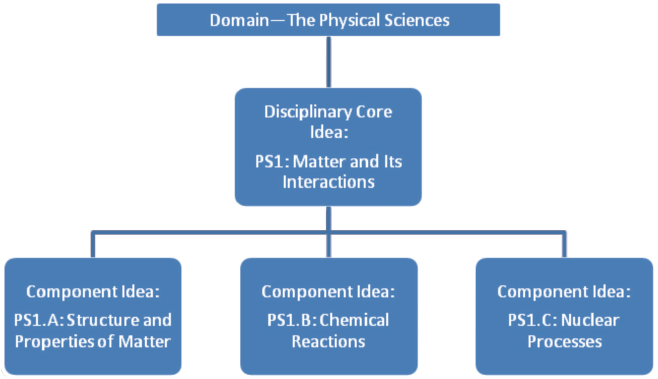
NOTE: This in an example from the Framework organization to demonstrate the relationship between “domains,” “disciplinary core ideas,” and “component ideas.”
Though the disciplinary core ideas (DCIs) were used as a starting point for building these model course maps, it will be important for coordinated learning that the other dimensions of the Framework—science and engineering practices (SEPs) and crosscutting concepts (CCs)—be woven together in classroom instruction (see #5 below). Curriculum designers should consult the Framework and the NGSS appendixes for progressions of learning for SEPs and CCs.
3. All Standards, All Students.
All standards are expected of all students. Though this is a foundational commitment of the Framework and is discussed at length in Appendix D of the NGSS, it bears repeating here because of its implications for course design. This approach is much more than just a way to refute the common notion that learning physics is only for students in advanced math, or that taking earth and space sciences is only for students who are not on the college track. All standards, all students.
For the 6–8 grade band, this clearly indicates that all of the grade-banded standards should be addressed within the 3-year span and the flexibility of the high school science courses sequence with required and elective courses provides a challenge to ensure that all students are prepared to demonstrate all of the PEs. The model course maps for the 9–12 grade band are all organized into three courses. This decision was made by balancing the “All standards, all students” vision with the reality of the finite amount of time in a school year. It would certainly be recommended that students, especially those considering careers in a science, technology, engineering, and mathematics (STEM)-related field, go beyond these courses to take STEM courses that would enhance their preparation. It should be noted here, however, that an extensive review of the NGSS by college professors of first-year science courses determined that the content in the NGSS does adequately prepare students to be college and career ready in science (see Appendix C). Furthermore, it should also be noted that there is no set amount of time assigned to these courses. Although traditionally these would be considered year-long courses, there is nothing in these models that requires that a course fit into a set amount of time—courses could be spread over a longer time than 3 years, extended to meet student needs, or accelerated. Some modes and settings
of instruction—such as proficiency or mastery-based learning, online learning, or alternative learning centers—may even find that structures other than courses are better fits for their situation. Even in these situations, the model course maps and the processes used in their development can help guide curriculum development.
4. Model Course Maps Are Not Curriculum.
The NGSS are student outcomes and are explicitly not curriculum. Even though within each NGSS PE the SEPs are partnered with a particular DCI and CC, these intersections do not predetermine how the three are linked in the curriculum, units, lessons, or instruction; they simply clarify the expectations of what students will know and be able to do by the end of the grade or grade band. Although considering where PEs will be addressed within courses is an important step in curriculum development, additional work will be needed to create coherent instructional programs that help students achieve these standards.
5. All Science and Engineering Practices and All Crosscutting Concepts in All Courses.
It is the expectation of all the model course maps that all SEPs and CCs will be blended into instruction with aspects of the DCIs in every course in the sequence and not just the ones that are outlined in the PEs. The goal is not to teach the PEs, but rather to prepare students to be able to perform them by the end of the grade band course sequence. The PEs are written as grade-band endpoints. Even though a particular PE is placed “in a course,” it may not be possible to address the depth of the expectation in its entirety within that course. It may, for example, take repeated exposures to a particular SEP over several courses before a student can achieve the proficiency expected in a given PE, but by the end of the grade band students should be prepared to demonstrate each PE as written.
6. Engineering for All.
As is more carefully detailed in Appendix I, the NGSS represent a commitment to integrate engineering design into the structure of science education by raising engineering design to the same level as scientific inquiry when teaching science disciplines at all levels, from kindergarten to grade 12. Engineering standards have been integrated throughout the science domains of the physical sciences, life sciences, and earth and space sciences. The NGSS also include PEs that focus explicitly on engineering design without a science domain context. Within the range affected by these model course maps, there are four engineering design PEs in the 6–8 grade band and four in the 9–12 grade band. All of the model course maps place the stand-alone engineering PEs with all courses as they help organize and drive instruction of the integrated engineering PEs within each course.
MODEL COURSE MAPS
Three model course maps are included as concrete examples to begin conversations about realizing the vision of the Framework and the NGSS. Before reading this section, it is important to read the preceding section, Foundational Understandings for the NGSS Model Course Maps.
Including the three options presented in this section does not preclude other organizational sequences. As states, districts, and teachers engage in conversations about the strengths and weaknesses of the model course maps presented here, it is expected that a wider variety of course maps will be collaboratively developed and shared. For example, a curricular and instructional program could be built around the National Academy of Engineering’s Grand Challenges for Engineering in the 21st Century or a community-based theme that runs through all the courses and connects the PEs to science, engineering, and technology used in everyday life or could focus on the Framework’s CCs or SEPs instead of the DCIs. Furthermore, as was mentioned above, even the term “courses” may be an unnecessarily limiting definition that privileges a time-based system. Some teachers, schools, districts, and states are moving toward a proficiency-based system, but even in such a situation these model course maps can help guide conversations about the connections between PEs and how to begin moving from standards to instruction focused on the NGSS student performance/outcomes.
After the following list, details about each model course map, how it was developed, and ideas for next steps are provided.
- Conceptual Progressions Model (grades 6–8 and 9–12)—The grade-banded PEs are organized so that student understanding of concepts is built progressively throughout the course sequence. This model maps PEs into courses based on what concepts are needed for support without focusing on keeping disciplines separate.
- Science Domains Model (grades 6–8 and 9–12)—The grade-banded PEs are organized into content-specific courses that match the three science domains of the Framework: physical sciences, life sciences, and earth and space sciences. Because the engineering domain is mostly integrated into the other three disciplines in the NGSS, it was integrated in these course models rather than presented as a separate course in this sequence. (The four stand-alone engineering PEs in each grade band are connected to all three courses at both levels.)
- Modified Science Domains Model (grades 9–12)—The grade-banded PEs are organized into content-specific courses that match a common high school course sequence of biology, chemistry, and physics. To ensure that all students have access to all standards, the PEs connected to the earth and space sciences domain of the Framework are divided among these courses. This model was included as a model for comparison because it is currently a common sequence in high schools across the United States.
Course Map 1—Conceptual Understanding Model (grades 6–8 and 9–12)
Process and Assumptions: How Was This Course Map Developed?
This model course map arranges PEs so that the component ideas of the DCIs in each course progressively build on the skills and knowledge described in courses that precede it. The fifth of the six foundational understandings for using model course maps includes the idea that although all three dimensions described in the Framework are specifically integrated within the grade band endpoints, curriculum and instruction will provide students with opportunities to learn the components of the dimensions in a variety of ways to prepare them to perform these endpoints.
Students should have multiple opportunities to engage all of the SEPs and CCs in each course. The premise of this Model Course Map 1, however, is that the DCIs do contain content that can be logically sequenced. Creating a logical sequence for the DCI portion of the PEs for this model course map was a multi-stage effort that relied heavily on the Framework.
The first step in this process was separating the core ideas based on their reliance on other core ideas. For example, it is clear just from the titles of the core ideas that to learn about LS1: From Molecules to Organisms: Structures and Processes, a student would benefit from an understanding of core idea PS1: Matter and Its Interactions. Knowing about atoms, molecules, and how they interact should enhance a student’s understanding of how
molecules operate in living organisms. This would put core idea PS1 in a course before core idea LS1. Just looking at the titles of the core ideas, however, is not enough to understand the full scope of what content is included in a core idea. Ordering core ideas for this model course map was done by thoroughly comparing the descriptions for each core idea in the Framework. Any core ideas that did not have significant reliance on the content in other core ideas were placed in the first course. Core ideas that required support from those in the first course were placed in the second course, and core ideas that required support from core ideas in the second course were placed in the third course. The resulting skeletal sequence based on disciplinary core ideas is shown in Figure K-2. As was discussed in the sixth foundational understanding for all model course maps, there are four PEs in each grade band that focus exclusively on engineering design. Although these PEs are not represented in the figure below, the stand-alone engineering PEs are included in all three courses, as they should help organize and drive instruction of the integrated engineering PEs in all three courses and they will appear in subsequent tables.
Sorting core ideas is a step in the direction of course mapping, but core ideas are at far too big a grain size to be useful for curriculum development. To get closer to a useable grain size, the core ideas were reanalyzed by splitting each one into its component ideas (identified in the Framework) and again sorting them into courses to refine their positioning. Essentially, the process used for sorting the DCIs was repeated, but the component ideas disconnected from the core idea and, when appropriate, moved to a different course in the map based on the grade band endpoint descriptions in the Framework. For example, although PS1: Matter and Its Interactions was originally placed in the first course, its component idea PS1.C: Nuclear Processes requires content in both Courses 1 and 2, so it was shifted to Course 3. PS1.A: Structures and Properties of Matter and PS1.B: Chemical
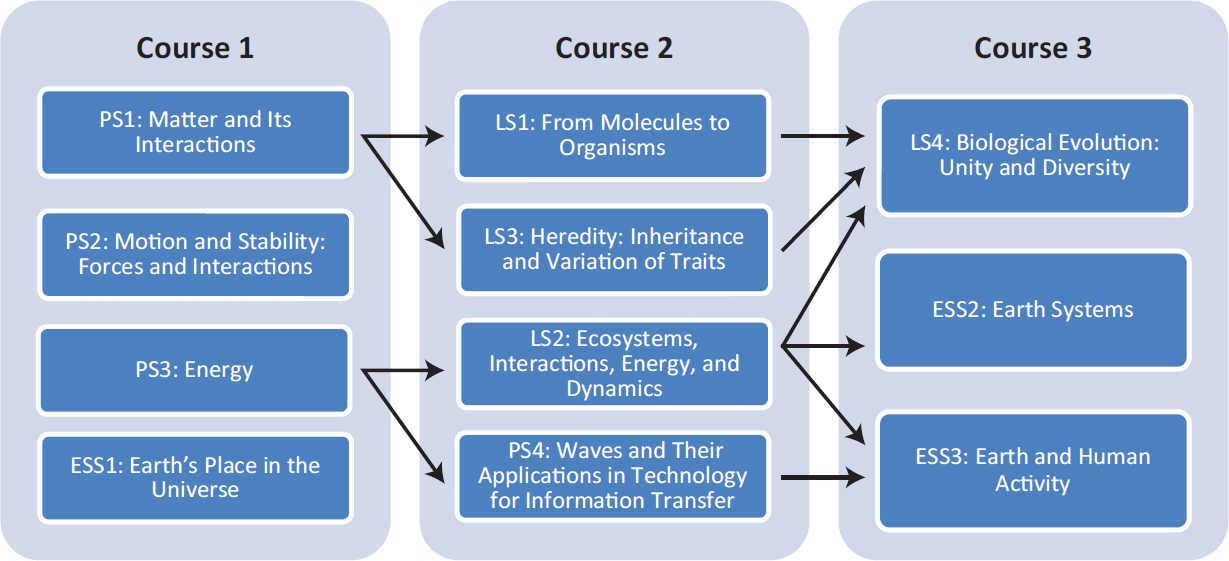
NOTE: This figure outlines the first step of organizing the NGSS into courses based on a conceptual progression of the science content outlined in the DCIs in the Framework.
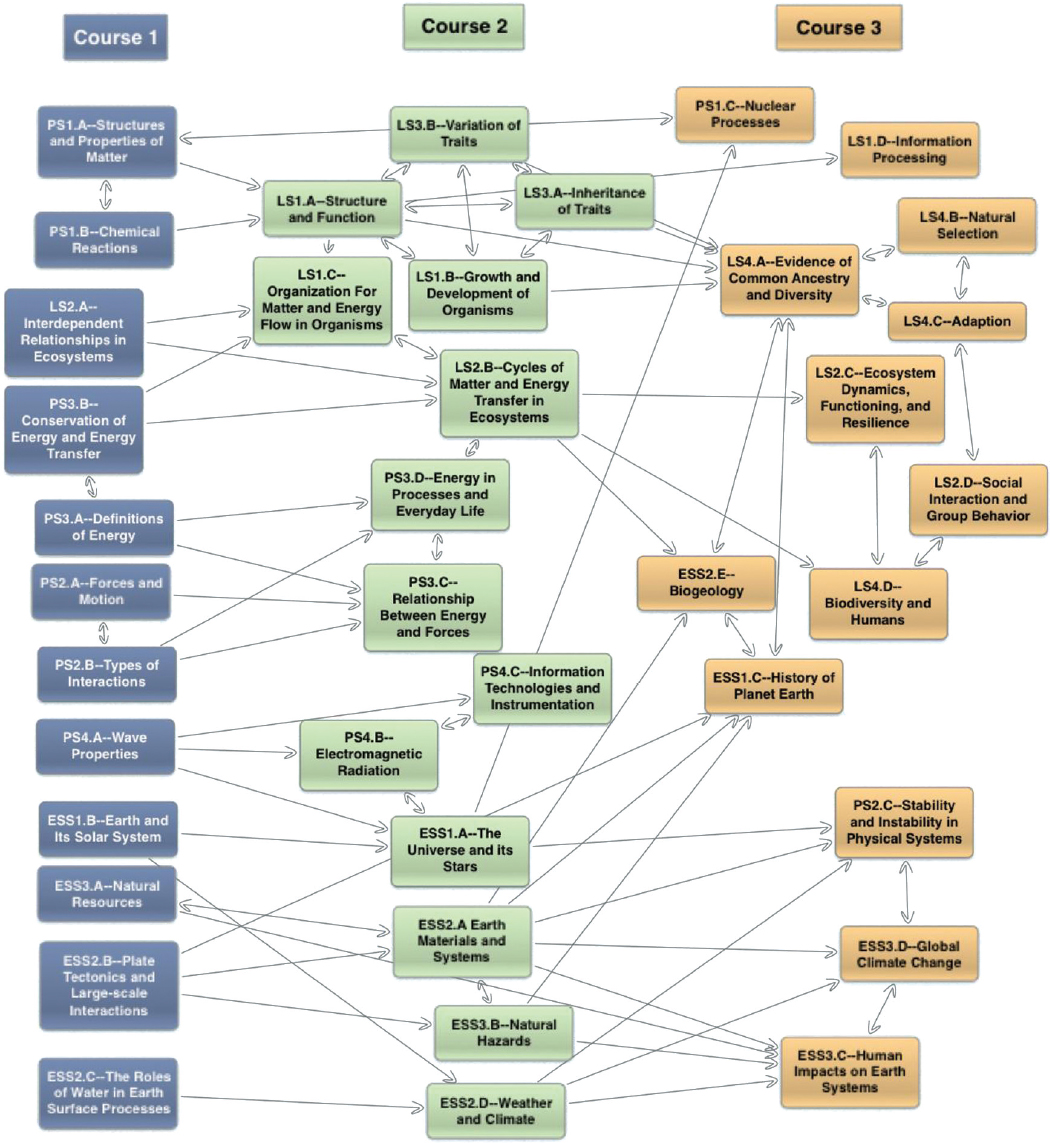
NOTE: This figure outlines the result of the second step of mapping the NGSS into courses—refining the arrangement in Figure K-2 by evaluating the DCIs at the finer grain size of the component ideas of which they are made. The arrows illustrate the connections that were used to sort the DCIs into courses, not to determine an order for curriculum.
Reactions remained in course one because they do not require content from other component ideas. Figure K-3 shows the end result of reassigning component ideas to courses. Because this organization is based on the Framework, it works for both the 6–8 and 9–12 grade bands.
The final step in the process of building Model Course Map 1 was to reevaluate the organization at the level of the PEs themselves. The tables below outline the first step in this process—connecting the component ideas with their PEs. These tables were built using the information in the NGSS foundation boxes, which document the connections between the PEs and each component idea. Due to the overlapping nature of the content in the component ideas, some PEs are linked to more than one component idea. In these cases, PEs are only listed once in the top section of the table. PE repeats—PEs that are connected to more than one component idea within a course or between courses—and secondary connections are identified in the bottom section of each table.
Next Steps for Course Map 1
It should be clear at this point that this course map will need revision as curricula are developed, but this arrangement should give a good starting point for conversations about what is taught when and why. To help guide these conversations, here are several recommendations and steps that states or districts should consider as they work from this starting point toward developing curricula and instructional unit plans:
- Revisit the suggested arrangements of DCIs and DCI component ideas to ensure that they progress from course to course in a logical fashion. In this process, make sure to read the descriptions of the core ideas and the component ideas in the Framework, rather than only relying on past experiences with those concepts or topics. This may mean ending up with a different arrangement than what is presented here, but collaboratively engaging a broad group of teachers and administrators in this process will result in courses that work for schools, teachers, and students and offers greater buy-in for implementation.
-
As PEs are bundled into curriculum units and lesson plans, it is important to balance this structured arrangement of PEs with
TABLE K-1 Conceptual Progressions Model Course Map—Middle School
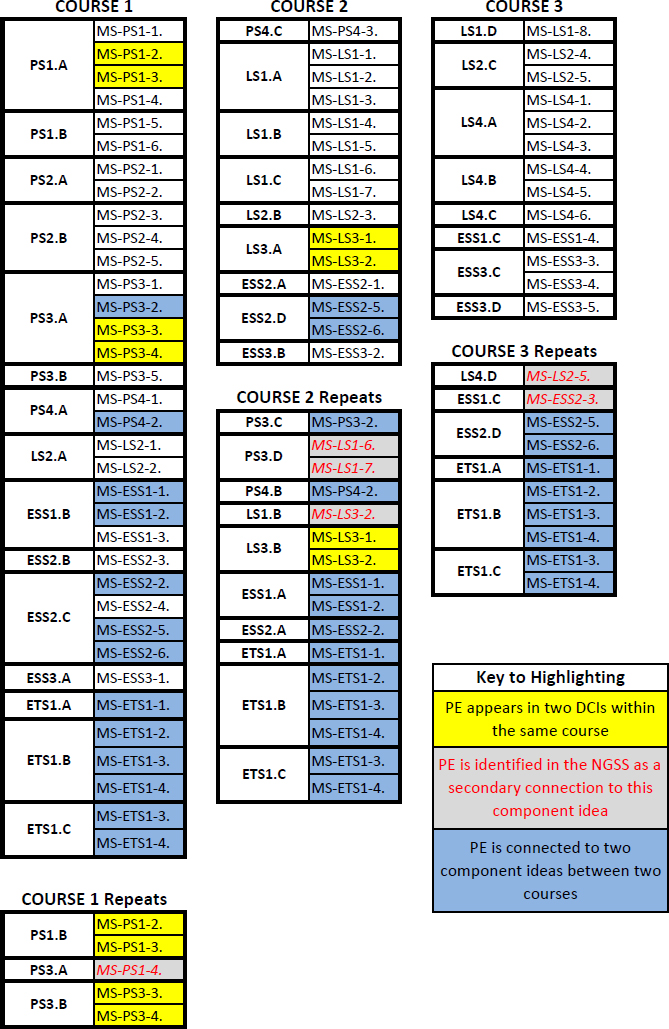
NOTE: This table connects the middle school NGSS PEs to the component ideas from the Framework. These connections are based on the information in the NGSS foundation boxes. In this table the component ideas are arranged into courses based on the organization shown in Figure K-3.
TABLE K-2 Conceptual Progression Model Course Map—High School
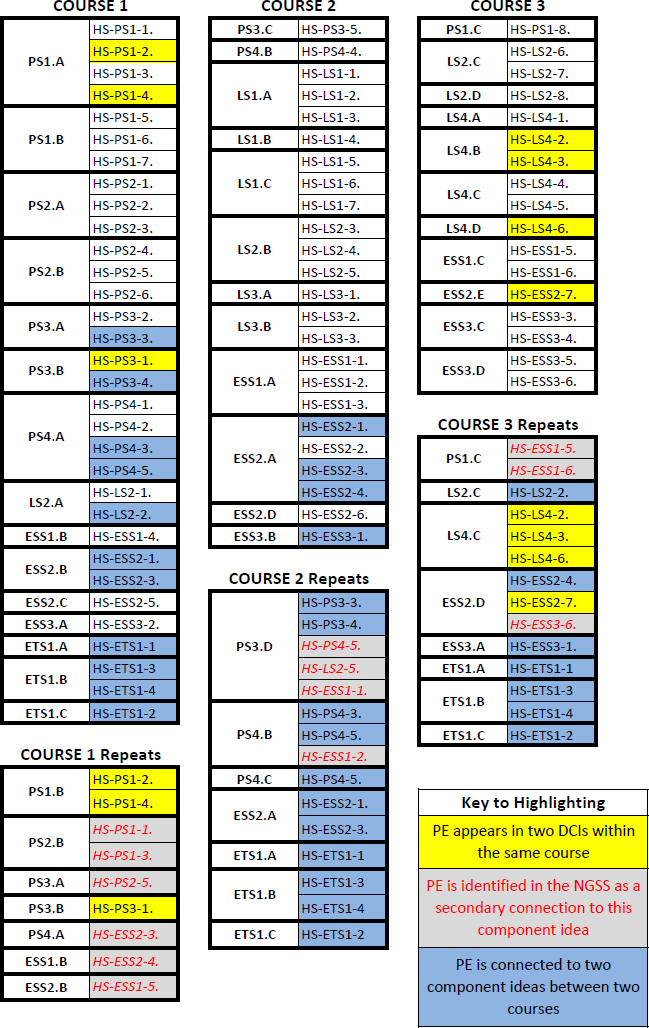
NOTE: This table connects the high school NGSS PEs to the component ideas from the Framework on which they were based. These connections are based on the information in the NGSS foundation boxes. In this table the component ideas are arranged into courses based on the organization shown in Figure K-3.
-
creating courses and units that flow well and engage students in learning. Use the final PE arrangement that is developed (or the one provided by Model Course Map 1) as a starting point for building instructional units. As the student outcomes described in the PEs are bundled into meaningful units to build flow within and between courses, PEs may well be pulled from different courses in the map to make this happen. The course map is there to make sure that when PEs are moved from one course to another, instruction is moved accordingly; it is not meant to be a prescriptive, static document. For example, one might decide to connect HS-ESS2-3 (“Develop a model based on evidence of Earth’s interior to describe the cycling of matter by thermal convection.”) and HS-PS3-2 (“Develop and use models to illustrate that energy at the macroscopic scale can be accounted for as either motions of particles or energy stored in fields.”) from Course 1 with HS-PS3-3 from Course 2 (“Design, build, and refine a device that works within given constraints to convert one form of energy into another form of energy.”) in an instructional unit that has students engaging in argumentation about sources of energy (gas, electric, geothermal, solar, etc.) for heating and cooling homes as a part of Course 1.
-
As PEs are bundled into instructional units and these units are tied together into courses, units may need to be moved from one course to another to make sure that courses are balanced. This does not necessarily mean that the courses have the same number of PEs. Curriculum units with fewer PEs may take longer than those with more PEs, depending on how those PEs are addressed in the lesson plans. It is recommended to pay particular attention to the repeat PEs listed in the tables in this process. PEs that are connected to more than one component idea may bundle better with the PEs in just one course rather than being represented in two courses.
-
When rearranging PEs and building instructional units, remember that the PEs are grade-banded student outcomes and to map out student course expectations appropriately. It may be that, although a PE is placed in a course, students may not be ready to perform all aspects of that PE by the end of the course. For example, a PE may be placed in the first course because the DCI dimension is determined to be foundational to a PE in the second course, but the depth of the SEP described
The math and English language arts (ELA) NGSS connections boxes and their supporting appendixes (Math—Appendix L; ELA—Appendix M) should be consulted to make sure that courses are not expecting math or ELA content or practices before they are expected in the science sequence. At the high school level, the Common Core State Standards (CCSS) also have grade-banded expectations, so this discussion will need to occur at the state, district, and building levels to make sure that the course map for science does not demand math and ELA performances before they are expected in those curricula. At the middle school level, there are two PEs (MS-PS3-1 and MS-PS4-1) that are presented in the course map before they are expected in the CCSS. This issue is addressed at length in the middle school revision below.
It also may be determined that getting all students prepared for all PEs requires more than three courses at the high school level. Organizing the standards into four science courses would simply mean repeating the process as described above, but sorting into four courses instead of three. In order for this to still align with the vision of the Framework of all PEs being for all students, all four courses would need to be required for all students. Alternatively, some education systems—especially those heading toward a proficiency-based system—could address some of the PEs in other course structures such as career and technical education, agriculture education, elective science courses, integrated mathematics or STEM courses, alternative education, or online modules.
in the PE may not be reached until the third year. The curriculum will need to be designed in a way that accounts for this reality. In other words, although the expectation is that all SEPs will be in all courses, it would make sense for students in grade 6 to engage differently from those in grade 8; one needs to deliberately build complexity of practices over the middle school sequence. Model Course Map 1 attempts to organize PEs in a way that scaffolds the content from course to course, but as these are rearranged for curriculum development, it may be that some core ideas in PEs may need scaffolding within a course to prepare students to learn the content.
NEXT STEPS EXAMPLE: MIDDLE SCHOOL REVISION
With work left to do on these models, it might seem overwhelming and difficult to move forward, so this section provides an example of the types of decisions that might be made to advance a revision. In this case the focus is on revising the Conceptual Progressions Model Course Map described in Table K-1. This revision pulls from several of the suggested next steps described above to provide an example of a result of this revision process.
John, Deb, and Carmen’s revisions are by no means exhaustive—more could be done along these same lines to truly adapt this model course map to local realities, and the decisions they made may not fit another’s reality—but continuing to engage in similar processes and collaborating on course map development within and between schools, districts, and states, along with continued research on the relative effectiveness of the implementation of different course maps, will better inform the next round of standards revision.
The revised middle school course map showing all of these changes can be found in Figure K-4, a component idea concept map, and also in Table K-3.
NEXT STEPS EXAMPLE: MIDDLE SCHOOL REVISION 2, STATE SPECIFIC MODEL
As mentioned in the introductory section, the middle school and high school standards are grade banded due to the fact that standards at these levels are handled differently in different states. As states move forward toward adoption these models should be referenced for guidance on how to arrange the PEs. States are encouraged to edit the sample models and turn them into state specific models to reflect an organization that works best for the state. There are many unique factors that may influence a state’s decision to arrange the PEs in a particular way.
The following is an example of a state revision where the focus is on revising the Conceptual Progressions Course Map described in Table K-1. This revision was developed by California’s Science Expert Panel (SEP), a group comprised of kindergarten through grade 12 teachers, scientists, educators, business industry representatives, and informal science educators.
The SEP used the following criteria to arrange the PEs for middle school grades six, seven, and eight:
- PEs were placed at each grade level so that they support content articulation across grade levels (from fifth through eighth grade) and provide the opportunity for content integration within each grade level.
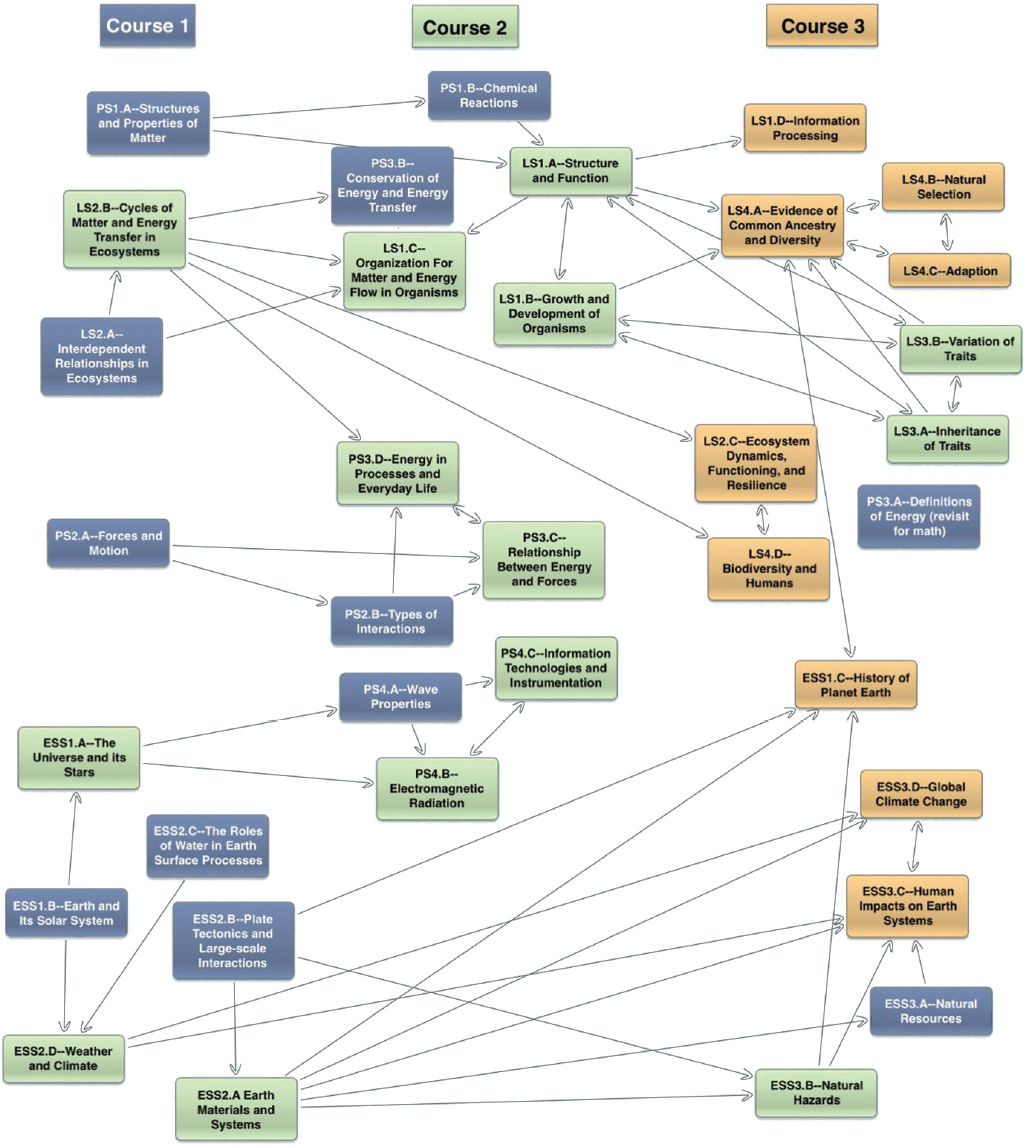
NOTE: This figure outlines the result of refining the arrangement in Figure K-3 using the process described in the Next Steps Example: Middle School Revision.
TABLE K-3 REVISED Conceptual Progressions Model Course Map—Middle School
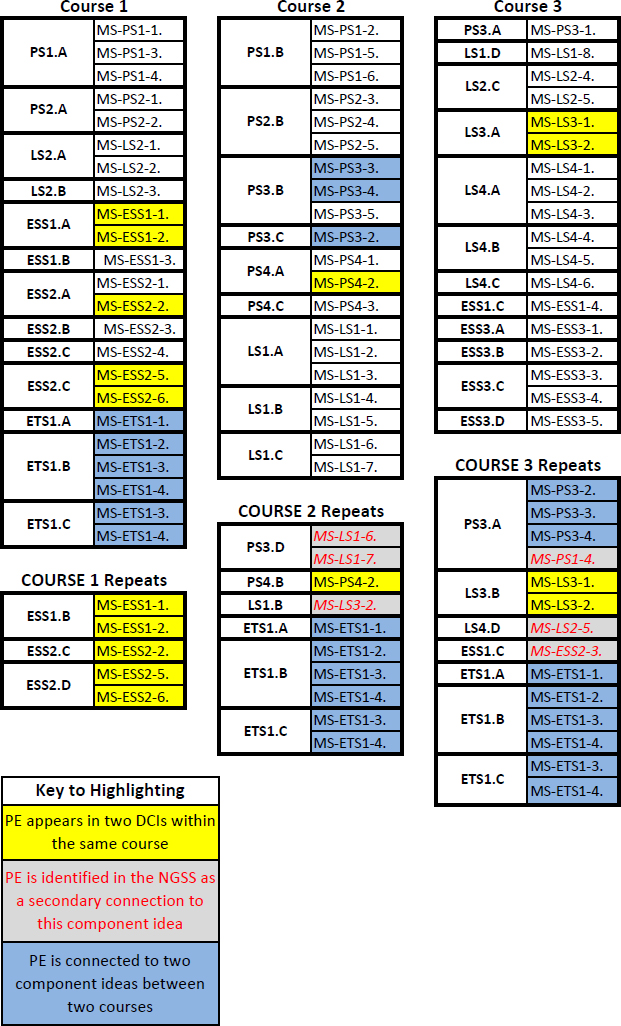
NOTE: This table connects the middle school NGSS PEs to the component ideas from the Framework. These connections are taken from the information in the NGSS foundation boxes. In this table the component ideas are arranged into courses based on the revised organization described above and shown in Figure K-4.
- Performance expectations were aligned with the CCSS in ELA and Mathematics so that science learning would not be dependent on math skills not yet acquired.
- The final arrangement of PEs reflected a balance both in content complexity and number at each grade level with human impact and engineering PEs appropriately integrated.
In addition to these criteria, the SEP worked to ensure that the PEs could be bundled together in various ways to facilitate curriculum development.
Course Map 2—Science Domains Model (grades 6–8 and 9–12)
Process and Assumptions: How Was This Course Map Developed?
This model course map was built by placing the NGSS PEs into a course structure defined by the science domains outlined in the Framework: One course is assigned to each science domain of the Framework—life sciences, physical sciences, and earth and space sciences. A fourth course is not included for the fourth domain of the Framework—engineering—as most of the NGSS PEs connected to engineering are integrated into the science domains through the SEPs and CCs. The NGSS do include four PEs in both the middle and high school grade bands that focus exclusively on core idea ETS1: Engineering Design. As noted in the sixth foundational understanding, these stand-alone engineering PEs are included with all three courses as they help organize and drive instruction of the integrated engineering PEs.
This model does not assume a particular order for these three courses. There is no conclusive research at this point to recommend one sequence over another, and there are a variety of factors that may affect the order determined for these courses if this model course map is selected as a starting point. Ideas for guiding this conversation are included in the next steps section following the presentation of the model.
This model course map is significantly less complicated in development relative to the Conceptual Progressions Model Course Map. The organization was essentially taken straight from the organization of the Framework. All component ideas from a given domain
TABLE K-3A California Integrated Learning Progressions Model—Middle School
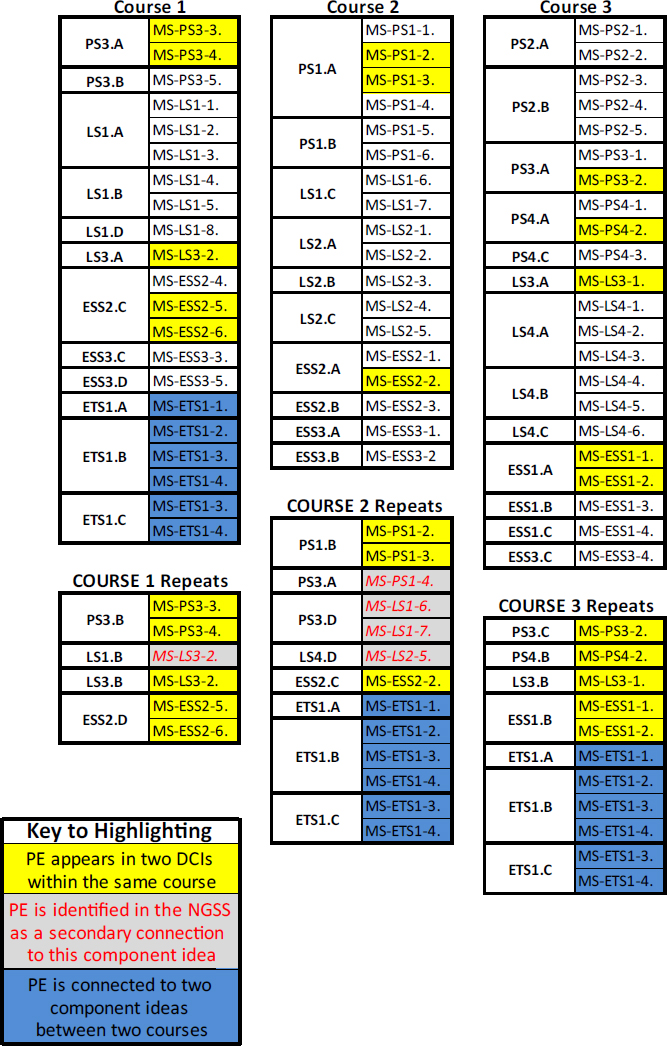
NOTE: This table connects the middle school NGSS performance expectations to the component ideas from the Framework. These connections are taken from the information in the NGSS foundation boxes. In this table, the component ideas are arranged into courses based on California’s revised organization.
and all of the PEs connected to each of those component ideas (as noted in the NGSS foundation boxes) were compiled to define each course. Tables K-4 and K-5 display the resulting organization of courses based on the domains model.
Next Steps for Model Course Map 2
Because the courses were effectively designed based on the parameters of the domains of science defined in the Framework, any significant shuffling of PEs between courses would, in some sense, void the initial premise of this model, but getting to this point was mainly about taking a first step toward curriculum, so there are several things to be considered in refining the model. As mentioned in the next steps section for Model Course Map 1, it is important to balance this structured arrangement of PEs with creating courses and units that flow well and engage students in learning. This model course map is another potential starting point for building instructional units. When bundling student outcomes into meaningful units to build the flow for courses, PEs may still be pulled from different courses in the map to make this work.
-
The order in which these courses would be offered was not predetermined by the course map, so a decision on how to sequence the courses will need to be made before proceeding with curriculum development. It is important to not sequence courses based only on current courses, but to also look in detail at the PEs mapped to each course (including what is required for math and ELA to accomplish the PEs) and to sequence courses to best benefit student learning. Figure K-3 and Tables K-1 and K-2 from Model Course Map 1 provide insight about the interconnected nature of the component ideas and how they support each other in a progression of content. A close examination of these resources and the next steps suggested for the first model course map are very relevant to this decision-making process. Additionally, the math and ELA connections boxes and their supporting appendixes (Math—Appendix L; ELA—Appendix M) should be consulted to make sure that courses are not requiring math or ELA content or practices before they are expected in the CCSS.
-
Regardless of the final sequence of courses, it is likely that some component ideas from other domains will need to be brought into each course. For example, if the life sciences course is taught before the physical sciences course, some
TABLE K-4 Science Domains Model—Middle School
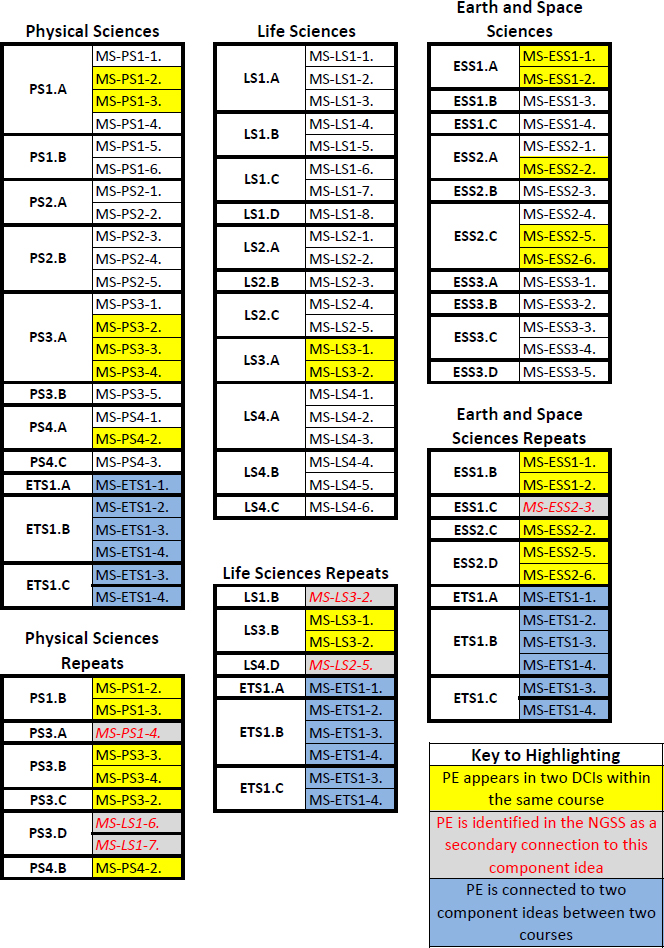
NOTE: This table connects the middle school NGSS PEs to the component ideas from the Framework on which they were based. These connections are based on information in the NGSS foundation boxes. In this table the component ideas are arranged into courses based on the organization described as the Science Domains Model—one course is assigned to each sciences domain of the Framework—life sciences, physical sciences, and earth and space sciences.
-
content from the physical sciences will need to be included in the life sciences course as prerequisite understandings for biological processes. As PEs are bundled into curriculum units and lesson plans it is important to balance this structured arrangement of PEs with creating courses and units that flow well and engage students in learning. The model course map can be used as a starting point for building instructional units. When bundling these student outcomes into meaningful units to build the flow for courses, PEs may be pulled from different courses in the map to make this work. The course map is not meant to be a prescriptive, static document; it is meant to provide structure for decision making
-
While rearranging PEs and building instructional units, it is important to remember that the PEs are grade-banded student outcomes and to map student course expectations appropriately. It may be that although a PE is placed in a certain course, students may not be ready to perform all aspects of the PE by the end of the course. For example, it could be that a PE is placed in the first course because the DCI dimension is determined to be foundational to a PE in the second course, but the depth of the SEP described in the PE may not be reached until the third year. The curriculum will need to be designed in a way that accounts for this reality. In other words, although the expectation is that all SEPs will be in all courses, it would make sense for students in grade 6 to engage in these differently than those in grade 8. Deliberately building complexity of practices over the middle school sequence is needed.
-
If, during the implementation process, restricting the 9–12 grade band to three courses does not meet local needs, a fourth course could be developed. If all four courses are required, a course map variation like this could still meet the vision of the NGSS and the Framework. Because the three domains fit fairly well into courses, there is no obvious way to siphon PEs into a fourth course, but an examination of Course Map Model 1 could provide direction to this process. Because the third course in that sequence contains PEs that are most dependent on content from other PEs, this would be a good starting point in determining which PEs should be considered for being a part of a fourth course.
TABLE K-5 Science Domains Model—High School
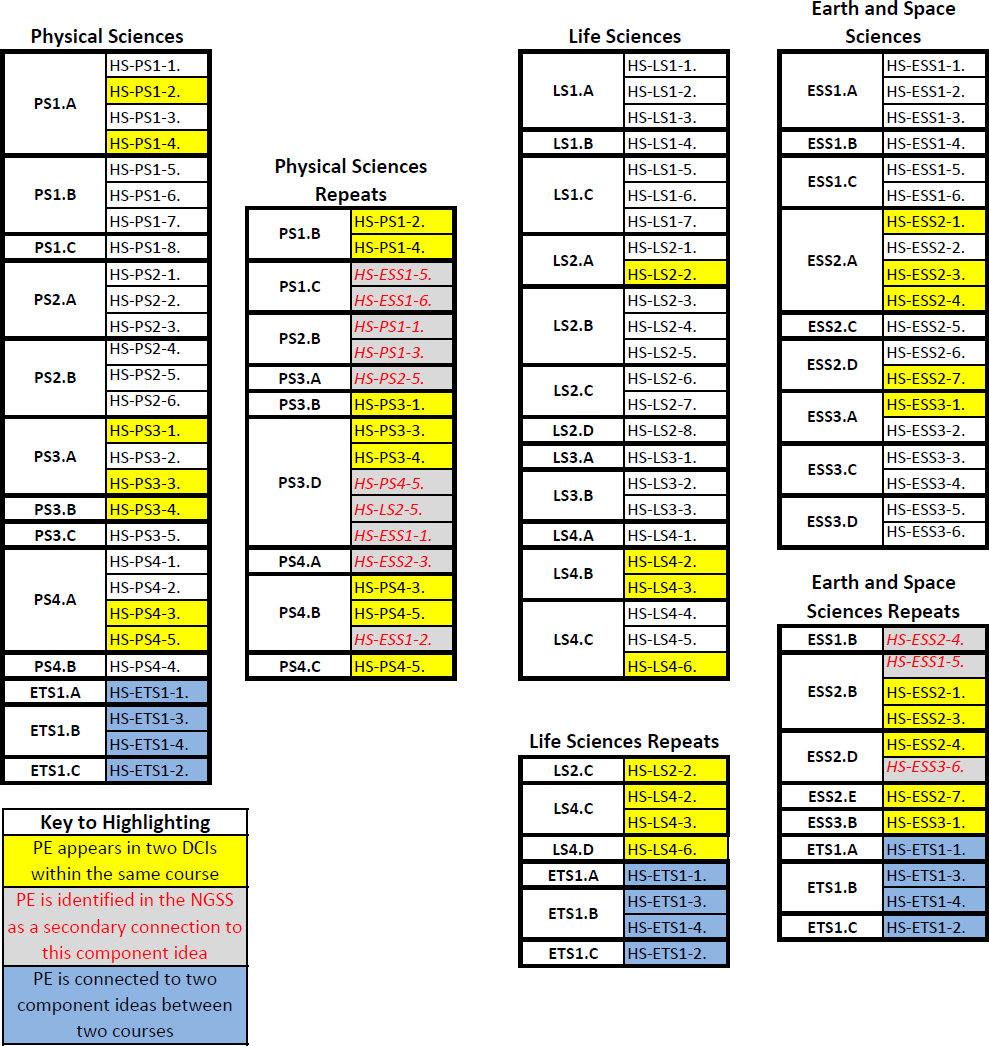
NOTE: This table connects the high school NGSS PEs to the component ideas from the Framework on which they were based. These connections are based on the information in the NGSS foundation boxes. In this table the component ideas are arranged into courses based on the organization described as the Science Domains Model—one course is assigned to each sciences domain of the Framework—life sciences, physical sciences, and earth and space sciences.
Course Map 3—Modified Science Domains Model (grades 9–12)
Process and Assumptions: How Was This Course Map Developed?
The model course maps presented here attempt to organize the 9–12 grade band PEs based on the frequently taught courses of biology, chemistry, and physics. These courses represent a very common course distribution across many states—either through legislation, regulation, or tradition—so these examples are presented as tools for evaluating how this commonly used course sequence overlays with the expectations of the NGSS. The challenge of this model course map was to also address the earth and space sciences because they are a domain outlined in the Framework, but do not have a course of their own in this organization. A fundamental understanding of the NGSS and all of the model course maps is that all PEs are for all students. Because few states currently require four high school science courses, this model examined how the earth and space sciences PEs could be distributed among the three courses already described.
Most of the NGSS engineering PEs are integrated into the other domains; however, in the final draft of the NGSS there are four PEs in each grade band that focus exclusively on engineering design. These stand-alone engineering PEs are included in all three courses because they should help organize and drive instruction of the integrated engineering PEs in all three courses.
The first step in mapping PEs to courses was to examine the component idea level of the DCIs and decide with which course the component ideas best aligned, along with the associated PEs (as noted in the foundation boxes of the NGSS). These decisions were made through a careful reading of the text describing the grade-band endpoints for each component idea in the Framework. This was easiest for the life sciences component ideas as they all ended up in biology. It was a more difficult step for the physical sciences component ideas as they had to be split between chemistry and physics courses.
The most challenging domain to organize into these three courses was the earth and space sciences as these PEs did not have a course of their own. Because a fundamental assumption of all of the model course maps is that all of the PEs of the NGSS are for all students and many states do not require four courses of science for high school graduation, the decision was made to attempt to distribute the earth and space sciences in a logical fashion across the biology, chemistry, and physics courses. This was done in a two-step process: First the 12 earth and space sciences DCI component ideas were assigned to a course based on their best conceptual fit; then the individual earth sciences PEs were sorted by their alignment to those component ideas. This was done using the alignment of PEs to component ideas in the DCI foundation boxes of the NGSS.
As with Model Course Map 2, no course sequence has been assumed in this model.
The assignment of the life sciences DCIs to biology is self-evident based on conventional course descriptions, as is the assignment of the earth sciences DCI component idea ESS2.E Biogeology. The component idea of ESS3.B Natural Hazards is placed in biology because it offers an opportunity to examine the impact of earth systems on organisms. Conversely, ESS3.C Human Impacts is attached to biology so that students can examine the impact of the human organism on other organisms and Earth systems. ESS1.C History of the Earth is included because of the interdependent nature of the co-evolution of the Earth system and living organisms.
The DCI component idea ESS3.A Natural Resources is included in chemistry because of the important role of many natural resources in chemical reactions that are crucial to modern human society. ESS3.A Global Climate Change is connected to chemistry because many Earth-based and atmospheric chemical processes drive systems that affect climate. Addressing ESS2.D Weather and Climate is then a logical progression once students better understand its driving mechanisms. ESS2.C Water in Earth’s Surface Processes is included because many of the geologic effects of water are a result of its molecular structure and chemical properties.
Forces, interactions, waves and electromagnetic radiation, and energy are historically all components of a physics course. The DCI component ideas ESS1.A The Universe and Stars and ESS1.B The Earth and the Solar System find their home in physics because of the understanding of motion and forces needed to explain their interactions. Similarly, understanding energy flow and the interactions of forces helps explain the mechanisms described in ESS2.A Earth Materials and Systems and also in ESS2.B Plate Tectonics.
Next Steps for Course Map 3
Course Map 3 lies in between Course Maps 1 and 2 in terms of needed refinement. The courses in this map were primarily driven by the domains of science defined in the Framework, but they are designed within the constraint of having biology, chemistry, and physics courses, with the earth and space sciences PEs split among courses. As was mentioned in the next steps sections for the previous two model course maps, it is important to balance this structured arrangement of PEs with creating courses and instructional units that flow well and engage students in learning. This PE arrangement can be used as a starting point for building instructional units. While bundling student outcomes into meaningful units to build flow for courses, PEs may be pulled from different courses in the map to make this work.
There are several other considerations when revising this model:
-
Much like Model Course Map 2, the sequence of courses is not predetermined, so deciding on an order would be one of the first decisions to make. It is important to not sequence courses based only on current courses, but to look in detail at the PEs mapped to each course (including what is required for math and ELA to accomplish the PEs) and to then sequence courses so as to best benefit student learning. Figure K-3 and Tables K-1 and K-2 from Model Course Map 1 provide insight about the interconnected nature of the component ideas and how they support each other in a progression of content. A close examination of these resources and the next steps suggested for the first model course map will support this decision-making process. Additionally, the math and ELA connections boxes and their supporting appendixes (Math—Appendix L; ELA—Appendix M) should be consulted to ensure that courses are not requiring math or ELA content or practices before the grade level indicated in the CCSS.
-
The split of earth and space sciences PEs also needs close examination to make sure that the PEs have been effectively arranged and that they fit the expectations of state or local courses. The sequence of courses may have a significant impact on which earth and space sciences PEs are placed in which course.
-
Table K-6, which outlines how the PEs are organized in this model course map, makes it clear that this map has an imbalance of PEs in each course. This deserves examination as PEs are bundled into instructional units to determine if any PEs (or even entire component ideas) should shift courses. The earth and space sciences PEs would be ready candidates for this move, but it might also be that a component idea, such as LS1.C Organization for Matter and Energy Flow in Organisms, might be moved from biology (which has the most PEs) to chemistry (which has the least). This move would also make sense because the content of LS1.C ties in nicely with some of the chemistry concepts. It should be noted here that simply counting the number of PEs in a course does not necessarily give a good sense of the time it will take to prepare students to be able to perform what is expected—this is better determined by the length of time needed for the instructional units that are developed.
-
While rearranging PEs and building instructional units remember that the PEs are grade-banded student outcomes and map student course expectations appropriately. It may be that, although a PE is placed in a course, students may not be ready to perform all aspects of the PE by the end of the course. For example, it could be that a PE is placed in the first course because the DCI dimension is determined to be foundational to a PE in the second course, but the depth of the SEPs described in the PE may not be reached until the third year. The curriculum will need to be designed in a way that accounts for this reality. In other words, although the expectation is that all SEPs will be in all courses, it would make sense for students in grade 6 to engage in these differently than those in grade 8. Deliberately building complexity of practices over the middle school sequence is needed.
-
Another solution to mesh the NGSS with an existing course sequence that includes biology, chemistry, and physics courses would be to add a fourth course—earth and space sciences—to the sequence. If all four courses are required, this variation would still meet the vision of the Framework that all PEs are
TABLE K-6 Modified Science Domains Model—High School
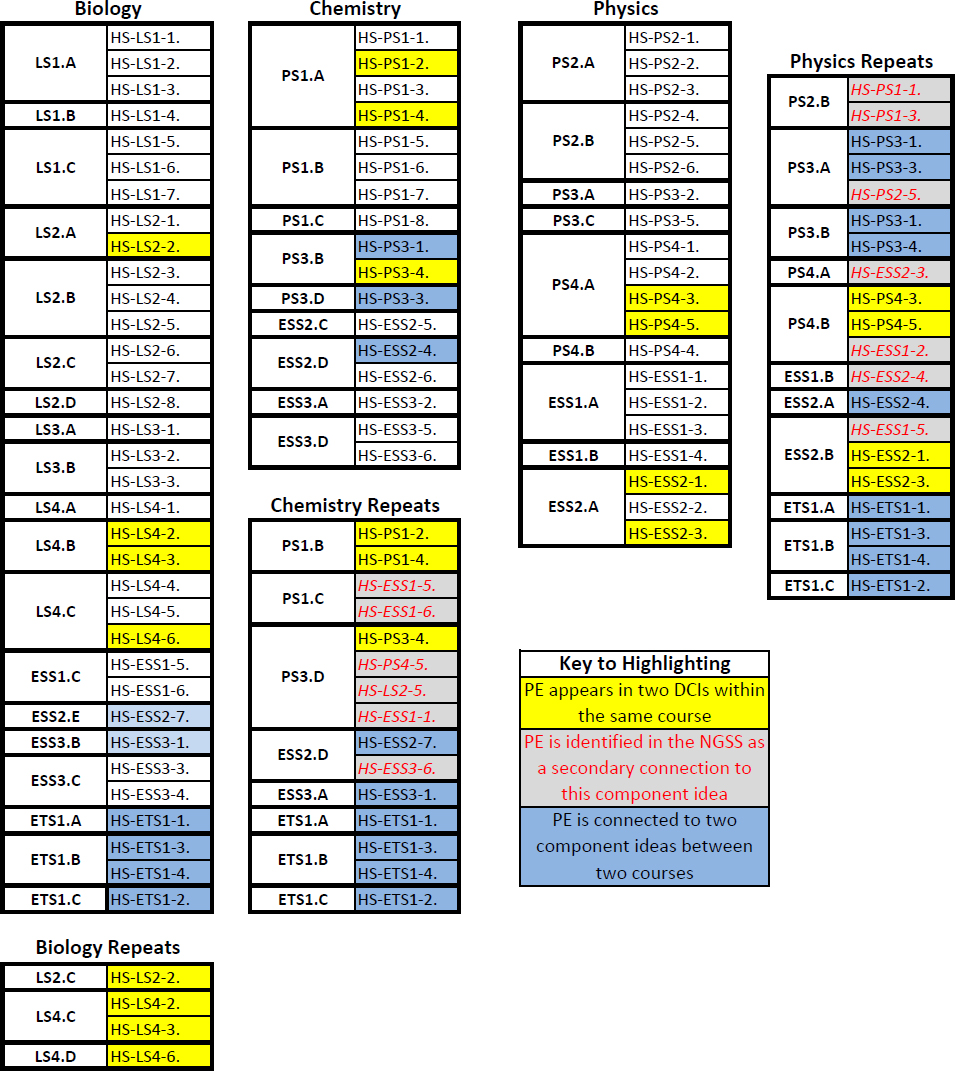
NOTE: In this table the component ideas are arranged into courses based on the organization described as the Modified Science Domains Model—biology, chemistry, and physics. The table uses the information in the NGSS foundation boxes to connect the high school NGSS PEs to the component ideas from the Framework.
expected for all students. Remember that these “courses” do not have a defined length of time—four courses does not necessarily mean 4 years.
NEXT STEPS EXAMPLE: REVISING THE MODIFIED SCIENCE DOMAINS MODEL—FOUR COURSES
The following vignette describes an experience that a high school might have in deciding to use the science domains model, but with revisions to make it a four-course model.
TABLE K-7 REVISED Modified Science Domains Model—Four Courses High School
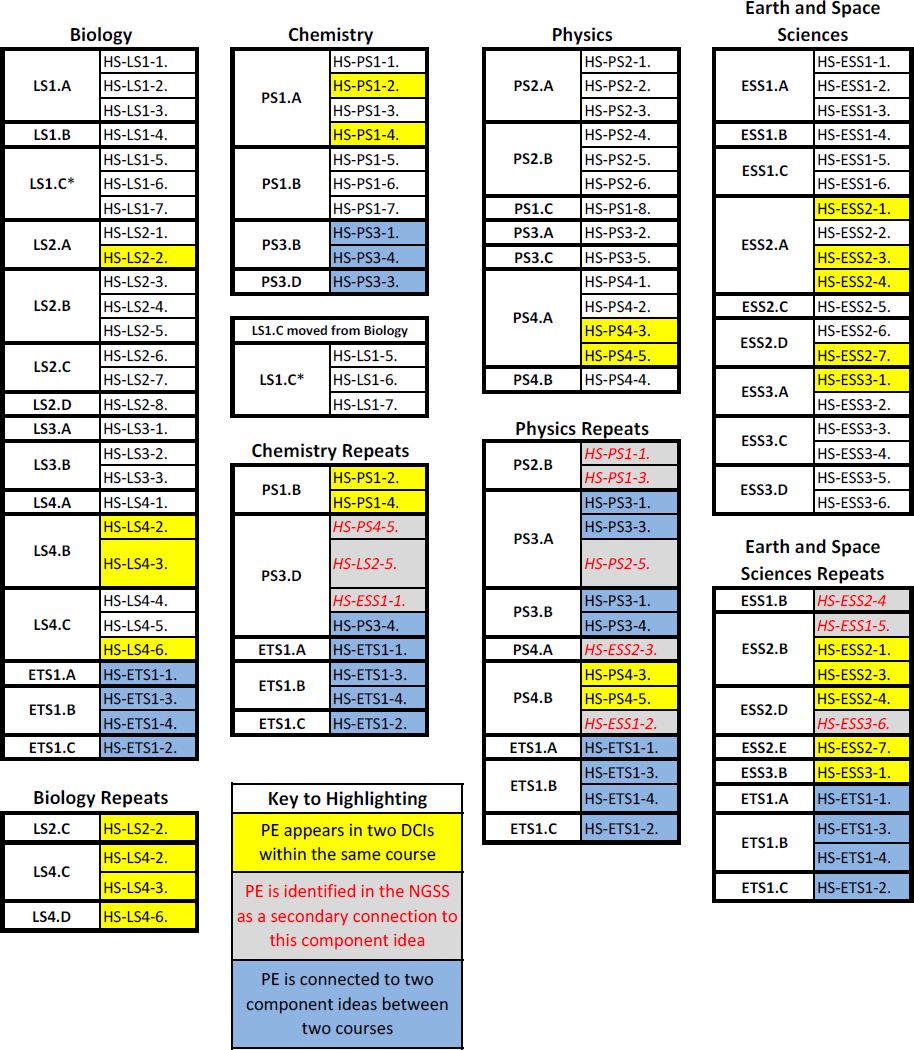
NOTE: In this table the component ideas are arranged into courses based on the organization described as the Modified Science Domains Model—biology, chemistry, and physics—with a fourth course added for the earth and space sciences. The table uses the information in the NGSS foundation boxes to connect the high school NGSS PEs to the component ideas from the Framework. *LS1.C moved from Biology to Chemistry.
COURSE MAPS AND IMPLEMENTATION
Choosing a Course Map
These course maps are not end products; they are models of processes for mapping PEs onto courses and starting points for continued work. They are by no means the only arrangements possible, but are intended to be concrete examples to start conversations about the direction of science education at the building, district, and state levels. This section highlights factors to consider in making a decision to use one, more than one (at different grade bands), or none of the model course maps presented.
Any course map will have benefits and challenges linked to the underlying assumptions and processes that were involved in making them and to the local situation where they are to be implemented. Of course, “benefits” and “challenges” depend on one’s perspective. Something identified as a “challenge” may actually be a primary reason for selecting a model if the challenge is one that is determined to be in the students’ best interest. For example, if a state education agency is already planning a redesign of teacher licensure criteria, then selecting a model course map that does not fit well with the existing teacher licensure system would not necessarily be a barrier to selecting that course map—it might even be a reason for selection because it aligns with the direction of the licensure redesign process. Likewise, what some may consider a “benefit,” others may see as a reason not to select a course map. Some may start with a particular course map because it contains courses that are very similar to what is currently offered, but others may see this as more of a drawback as it may result in teachers being less convinced they need to make any changes—making it difficult to ensure a complete and coherent implementation of the vision of the Framework. The realities and needs in states and local education agencies (LEAs) are quite different; therefore, outlined below are factors to consider in deciding how to map the grade-banded PEs onto courses for the NGSS.
Factors for Consideration
-
Are the performance expectations organized in a way to maximize student learning?
Course Map 1, Conceptual Understanding, was the only model that was consciously designed with this in mind. DCI component ideas and their related PEs are deliberately sequenced to allow students to build knowledge in a logical progression. This model supports students’ engagement in SEPs and applies CCs to deepen students’ understanding of the core ideas in the physical sciences, life sciences, and earth and space sciences over multiple years (NRC, 2012, p. 8). According to the Framework, “By the end of the 12th grade, students should have gained sufficient knowledge of the practices, crosscutting concepts, and core ideas of science and engineering to engage in public discussions on science-related issues, to be critical consumers of scientific information related to their everyday lives, and to continue to learn about science throughout their lives” (NRC, 2012, p. 9).
This does not mean that, through effective curriculum planning and lesson plan development, the other models course maps could not be developed in a way that would also maximize student learning, but their infrastructure was not designed with this as a focus. With an organizational structure built directly from the domains of the Framework (Course Map 2) or traditional scientific divisions (Course Map 3), it will take a concerted effort to ensure that there are opportunities to build conceptual knowledge over time, especially for concepts that are cross-disciplinary.
-
Are the performance expectations organized in a way that increases efficiency in instruction?
Among the many recommendations for improving the coherence and effectiveness of the K–12 curriculum, Designs for Science Literacy (AAAS, 2001) is a cross-disciplinary organization that eliminates the unnecessary repetition of topics—the same ideas in the same contexts, often with the same activities and the same questions. A common student complaint is that the same topics are presented in successive grades, often in the same way. Similarly, a common teacher complaint is that students did not receive instruction in important topics in prior
-
grades and so these topics then have to be taught in the present grade, thus perpetuating an instructional gap for the following grades (AAAS, 2001).
In Course Map 1 the thoughtful sequence of DCI component ideas and PEs limits unnecessary repetition while still providing students with the requisite knowledge for success in subsequent science courses. Course Maps 2 and 3 were not designed with this in mind, and although the order that courses are sequenced within either model could alleviate some of this, there are PEs within every course that expect students to know concepts that are being addressed in other courses. If this is addressed thoughtfully in curriculum design, it could provide opportunities for cross-disciplinary connections, but in terms of instruction efficiency, it does mean that there will be times that teachers will have to allot class time to bring students up to speed on the background concepts necessary to progress to the concepts intended to be addressed in any given course.
-
Are the performance expectations organized in a way that represents the interconnectedness of science?
The organization of scientific research has become more complex and has evolved from the Committee of Ten’s constructs of 1893, which organized K–12 science education around astronomy, meteorology, botany, zoology, physiology, anatomy, hygiene, chemistry, and physics. The cross-disciplinary organization of Course Map 1 makes natural connections across the science domains of the Framework more evident to teachers and students and provides for a more flexible, coherent, and realistic pathway to developing deep understandings of science. Course Maps 2 and 3 were not designed with this in mind, although careful curriculum and lesson plan development could create these connections.
-
How does the course map align with current state guidelines/ legislation/policies for course titles, course sequences, teacher licensure, credits for graduation, and college admissions expectations?
States vary in terms of how these policies are created and the processes that are involved in changing them, but these are all important factors for consideration in selecting or developing a course map. For example, some states require only two science credits for graduation, but the NGSS PEs are written for all students and none of the model course maps include fewer than three courses. “Credit” and “courses” do not describe what students know or are able to do; the system of PEs in the NGSS, all of which are for all students, detail what is to be achieved.
-
What are the implications for teaching positions?
Any of the course map models (depending on the realities of current teacher preparation and licensure policies, current course offerings, graduation requirements, course sequences, etc., and any changes that are proposed) may have a significant impact on the number of teachers prepared to teach courses. This could also be affected by the proposed sequencing of courses in Course Maps 2 and 3. For example, switching from a biology–chemistry–physics sequence in a state where biology is the only “required” science in a sequence of three required for graduation to using Course Map 2 and sequencing physical sciences–life sciences–earth sciences courses will put different demands on the system to provide teachers qualified to teach these courses. This would also potentially impact teacher certification/licensure policies, teacher preparation, and professional learning opportunities.
-
How do these course maps affect the focus of pre-service teacher preparation and professional learning opportunities?
Transitioning from current state science standards to the NGSS provides significant opportunities to support advancing science instruction regardless of the course map that is utilized. Teachers of science will need intensive, ongoing, and job-embedded professional development in order for their students to meet the challenges of the PEs defined in the NGSS. Teachers will need to wrestle with questions such as:
- What do we want students to learn?
- How will we know what students are learning?
- How will we respond when they do not learn?
The cross-disciplinary approach of Course Map 1 is somewhat different than common current practice in teacher preparation and professional development. Pre-service teachers are less likely to have experienced an explicitly cross-disciplinary course in their own courses, which will mean that those responsible for
-
preparing them to be teachers will have to explicitly incorporate this into teaching and learning experiences. Many teachers already in the field are very passionate about the particular domain they are teaching. They may have accumulated a significant amount of knowledge of practices and core ideas within a content area and may have less experience outside their preferred domain. If Course Map 1 is used, professional learning opportunities will need to be carefully crafted to value this expertise and support teachers in making any transition.
Course Map 2 does not require a specific focus for teacher preparation or professional learning other than the focuses called for in transitioning to the NGSS.
Course Map 3 would also require a specific focus on teacher preparation and professional learning opportunities. Incorporation of the earth and space sciences PEs across biology, chemistry, and physics courses may not align with current practice. Teacher preparation and professional learning opportunities will need to be explicitly designed to support teachers in this transition.
-
Does the course map affect any plans for communicating about science education with stakeholders?
In adopting the NGSS (an assumed step if now choosing a course map of these standards), communication with key stakeholders—students, parents, teachers, administrators, school boards, business and industry, etc.—will be important to support effective implementation. The course map model that is used may require additional specific communication with messaging targeted for stakeholder groups, particularly if the course map requires significant system changes.
-
How is the chosen course map impacted by resource availability?
Existing resources, such as textbooks, workbooks, and even online resources, often sort information based on content in a way that is more similar to Course Maps 2 and 3. For states or districts that focus curriculum on a particular textbook, this may affect the decision of how to map courses, but for others that pull from a variety of resources and already use textbooks as a support for curriculum rather than as the curriculum, this may be irrelevant. As new resources are written and existing resources are rewritten for the NGSS, they might be more frequently designed with one course map or another in mind, but this too may be less of a concern due to the development of more flexible resources, such as open education resources and editable digital textbook formats.
CONCLUSIONS
It may seem a forgone conclusion that the course map specifically designed to coherently build student conceptual understanding over time, maximize efficient use of class time, and prepare students for the cross-disciplinary reality of science research will be the one that everyone selects, but there may be good reasons for choosing a different model (including “none of the above”). In fact, engineering an effective learning program is a complex and challenging task that depends on instructor knowledge of the content and pedagogy, materials that support good instruction, determination and implementation of learning progressions, assessments for formative and summative purposes, and even school climate—issues much beyond the goals of this appendix. Hopefully the factors described above will result in meaningful conversations in states and districts about their science education systems. Adopting the NGSS will require systemic changes to implement them with fidelity to the vision of the Framework. It is a great opportunity for deliberate decision making about whether or not a school system is designed in a way that gives students the best opportunities possible to realize this vision. Deciding on a course map is just one of the important decisions in this process, but it requires careful consideration because of the potential impacts across the system.
This situation of many states and districts utilizing the same standards, but with different course maps also has significant potential to inform our understanding of how students learn science. As mentioned in the beginning of this chapter, the reason all educators implementing the NGSS even have to juggle the idea of multiple course maps is that there is insufficient research to recommend a particular sequence. With 50 different sets of state standards, it has been difficult to determine if one sequence is more effective than another, but with many states considering adoption of these standards, there is fertile ground for historic research to move our understanding forward.
Developing a New Course Map
It might be that none of the course maps presented here meet the needs of a particular state or LEA. If this is the case, it would definitely make sense to design a new, individual course map model rather than simply refine what has been provided. The multi-dimensionality of the NGSS would certainly allow for a course map based on something other than just DCIs—either by one of the other dimensions or a combination of the three. These and other reasons for developing alternative course map models are certainly valid, but hopefully there is enough in the descriptions above to make this process a bit smoother. Examining the underlying assumptions of these course maps, reviewing the processes that were used to create the course maps, and weighing all this with the factors for consideration described above provides a framework to jump-start the development of new course maps that meet the needs of the students in an LEA or state.
Refining a Course Map
Selecting one of the course maps provided here does not mean the work is done; it is the first step in a journey. The course map will need further refinement to meet local needs. Then the real work begins to develop curricula and lessons based on the course map, and necessary professional learning opportunities will need to be accessed or developed to support implementation with fidelity. Additionally, as with all scientific endeavors, it will be necessary to plan how it will be determined whether efforts are successful. What types of data will be used to determine whether or not the new arrangement has worked? What processes will be put in place to refine a course map to increase its effectiveness? Even once these questions have been answered, as curriculum units and lesson plans are designed and refined in the classroom, it is likely that further refinement of the course map will be necessary.
Recommendations for refining each course map are provided at the end of each model description above, but more significant revisions may be in order if the underlying assumptions described in the beginning of this chaper are not acceptable. For example, if a state requires four courses in science and there is no intention to change this, then a three-course sequence for high school may not what is needed. This may mean that the models presented here will need to be refined—perhaps simply re-sorting PEs in Course Map Model 1 into four courses or using Course Map Model 3 with a separate earth and space sciences course rather than splitting the earth and space sciences PEs across biology, chemistry, and physics—or it may mean starting from scratch.
Additional work will need to be done locally to consider the mathematics expected by the PEs in both middle school and high school grade bands. As local mathematics courses may differ, especially at the high school level, it will be important to have cross-disciplinary conversations to make sure that students are receiving complementary instruction across content areas. The connections boxes in the NGSS should inform this conversation.
REFERENCES
AAAS (American Association for the Advancement of Science). (2001). Designs for science literacy. New York: Oxford University Press.
NRC (National Research Council). (2012). A framework for K–12 science education: Practices, crosscutting concepts, and core ideas. Washington, DC: The National Academies Press.

























